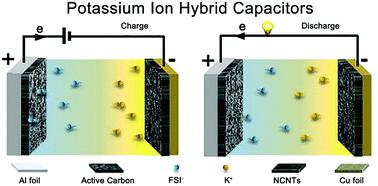当前位置:
X-MOL 学术
›
Nanoscale Horiz.
›
论文详情
Our official English website, www.x-mol.net, welcomes your feedback! (Note: you will need to create a separate account there.)
Nitrogen-doped carbon nanotubes as an anode for a highly robust potassium-ion hybrid capacitor
Nanoscale Horizons ( IF 9.7 ) Pub Date : 2020-09-28 , DOI: 10.1039/d0nh00451k Xiuqi Li 1, 2, 3, 4 , Maoxin Chen 1, 2, 3, 4 , Lei Wang 1, 2, 3, 4 , Hanjiao Xu 1, 2, 3, 4 , Jiang Zhong 1, 2, 3, 4 , Meng Zhang 1, 2, 3, 4 , Yaya Wang 1, 2, 3, 4 , Qiusheng Zhang 1, 2, 3, 4 , Lin Mei 1, 2, 3, 4 , Tao Wang 1, 2, 3, 4 , Jian Zhu 1, 2, 3, 4 , Bingan Lu 2, 3, 4, 5 , Xidong Duan 1, 2, 3, 4
Nanoscale Horizons ( IF 9.7 ) Pub Date : 2020-09-28 , DOI: 10.1039/d0nh00451k Xiuqi Li 1, 2, 3, 4 , Maoxin Chen 1, 2, 3, 4 , Lei Wang 1, 2, 3, 4 , Hanjiao Xu 1, 2, 3, 4 , Jiang Zhong 1, 2, 3, 4 , Meng Zhang 1, 2, 3, 4 , Yaya Wang 1, 2, 3, 4 , Qiusheng Zhang 1, 2, 3, 4 , Lin Mei 1, 2, 3, 4 , Tao Wang 1, 2, 3, 4 , Jian Zhu 1, 2, 3, 4 , Bingan Lu 2, 3, 4, 5 , Xidong Duan 1, 2, 3, 4
Affiliation

|
Potassium ion hybrid capacitors (KIHCs) have drawn growing interest owing to their outstanding energy density, power density and excellent cycling stability. However, the large ionic radius of potassium triggers a huge volume change during continuous K+ insertion/extraction processes, restricting the development of KIHCs. Here, we report N-doped carbon nanotubes (NCNTs) for high-performance K+ storage. The NCNTs possess a hierarchical structure and N functional groups and not only offer sufficient space to relieve the volume expansion, but also provide highly efficient channels to transport electrons and ions. As a result, the NCNTs anode presents a high specific capacity and an excellent cycling stability with an average decay rate of 0.0238% per cycle (the lowest value among the reported carbon-based anodes for K-ions batteries) during 3600 continuous cycles. A potassium ion hybrid capacitor (KIHC) was also designed with the NCNT anode and a commercial active carbon cathode and achieved both a high energy/power density (117.1 W h kg−1/1713.4 W kg−1) and a long cycle life (2000 cycles at 1 A g−1). Moreover, the in situ Raman and ex situ element mapping characterization demonstrate the outstanding electrochemical reversibility of the NCNTs. This work provides a superior strategy to design low-cost anode materials with excellent K+ storage electrochemistry.
中文翻译:

氮掺杂碳纳米管作为高强度钾离子混合电容器的阳极
钾离子混合电容器(KIHC)由于其出色的能量密度,功率密度和出色的循环稳定性而引起了越来越多的关注。然而,钾的大离子半径在连续的K +插入/萃取过程中触发了巨大的体积变化,从而限制了KIHC的发展。在这里,我们报告了用于高性能K +的N掺杂碳纳米管(NCNT)存储。NCNT具有分层结构和N个官能团,不仅提供了足够的空间来缓解体积膨胀,而且还提供了高效的通道来传输电子和离子。结果,NCNTs阳极表现出高比容量和出色的循环稳定性,在3600个连续循环中,每个循环的平均衰减率为0.0238%(在报道的用于K离子电池的碳基阳极中,最小值)。还设计了带有NCNT阳极和商用活性炭阴极的钾离子混合电容器(KIHC),实现了高能量/功率密度(117.1 W h kg -1 /1713.4 W kg -1)和长循环寿命(在1 A g -1时2000次循环。而且,就地拉曼和易地元素分布特征表现出NCNTs的优秀电化学可逆性。这项工作为设计具有出色K +存储电化学性能的低成本阳极材料提供了一种出色的策略。
更新日期:2020-11-03
中文翻译:

氮掺杂碳纳米管作为高强度钾离子混合电容器的阳极
钾离子混合电容器(KIHC)由于其出色的能量密度,功率密度和出色的循环稳定性而引起了越来越多的关注。然而,钾的大离子半径在连续的K +插入/萃取过程中触发了巨大的体积变化,从而限制了KIHC的发展。在这里,我们报告了用于高性能K +的N掺杂碳纳米管(NCNT)存储。NCNT具有分层结构和N个官能团,不仅提供了足够的空间来缓解体积膨胀,而且还提供了高效的通道来传输电子和离子。结果,NCNTs阳极表现出高比容量和出色的循环稳定性,在3600个连续循环中,每个循环的平均衰减率为0.0238%(在报道的用于K离子电池的碳基阳极中,最小值)。还设计了带有NCNT阳极和商用活性炭阴极的钾离子混合电容器(KIHC),实现了高能量/功率密度(117.1 W h kg -1 /1713.4 W kg -1)和长循环寿命(在1 A g -1时2000次循环。而且,就地拉曼和易地元素分布特征表现出NCNTs的优秀电化学可逆性。这项工作为设计具有出色K +存储电化学性能的低成本阳极材料提供了一种出色的策略。


























 京公网安备 11010802027423号
京公网安备 11010802027423号